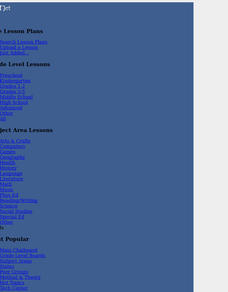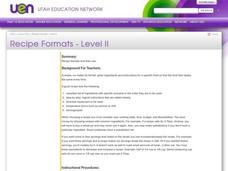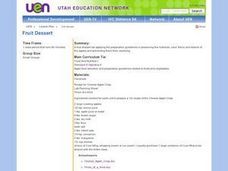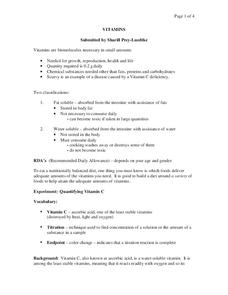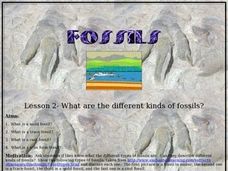Curated OER
Vegetable Lab
Third graders prepare vegetables using common methods: au gratin, minimum water method, broiled, panfry, frozen, and stuffed. They share with the rest of the class and determine which methods preserve nutrients, color, flavor and texture.
Curated OER
Cooking on a Budget
Learners explain if they like expensive or less expensive brands. They choose and eat a complete meal and evaluate themselves on its cost, nutrition and taste.
Curated OER
Potato Chips Fragility
Students investigate why some potato chips crumple faster than others. In this physics lessons, students relate the cooking time to potato's fragility. They write a lab report about their findings.
Curated OER
Ethnic Foods Exchange
Students examine the following topics: geography and culture, types of foods, cooking utensils, and cooking techniques used. They present in groups, then prepare ethnic food products.
Curated OER
Density of Liquids
Students explore the density of liquids. In this scientific inquiry lesson plan, students discover the density of water, corn syrup, and cooking oil through an experiment. In addition, students will draw and label pictures of the...
Curated OER
Volcano Under the City
Students examine the different flow rates of liquids and how lava's viscosity influences flow. In this liquids lesson students complete several handouts and a lab activity.
Curated OER
Recipe Formats - Level II
Students prepare chocolate chip cookies (or another recipe of choice) in the lab to give them practice in measuring, reading a recipe, using equipment, work habits, etc.
Curated OER
Baby Peanut Plants
Science is a subject ripe with opportunities to read informational text. Kids read to learn about peanuts! They read an informational passage, fill out two comprehension worksheets, and then conduct a lab experiment on a peanut. The...
Curated OER
A Global Water Crisis
Students study the contamination of drinking water and what human activities play a role in it. In this environment lesson students complete worksheets and complete a lab activity.
National Renewable Energy Laboratory
Biomass: Biogas Generator
It's a gas. Middle schoolers build a biogas generator following the directions in this resource. After a few days of observation, they demonstrate that the gas given off by the decomposing manure is flammable. The activity concludes as...
Curated OER
Microwave Introduction
Sixth graders learn the principles of microwave cooking and how to use and care for it properly while preparing foods.
Curated OER
You are the Microbiologist
In this lesson, young scholars demonstrate comprehension of basic lab techniques by properly using these techniques in preparing a laboratory investigation, demonstrate synthesis of prior lab experiences by solving a new problem using...
Curated OER
Fruit Dessert
Third graders complete a fruit lab applying the preparation guidelines in preserving the nutrients, color, flavor and texture of the apples and preventing them from oxidizing.
Curated OER
Vegetable Lecture and Experiment
Third graders experiment and answer questions to identify preparation guidelines to preserve the nutrients, enhance the color, flavor and texture of vegetables when cooking.
Curated OER
The Effects of the Calcium Ion on Cooked Dry Beans
High schoolers investigate the effects of calcium ions on the quality characteristics of cooked dry beans. In this calcium ion and dry bean investigation lesson plan, students soak dry beans using 2 different soaking techniques and 2...
Curated OER
Vitamins
High schoolers determine the amount of vitamin C present in 3 samples of juice stored in various light conditions. In this vitamin lesson plan, students investigate the amount of vitamin C present in juice exposed to different quantities...
Curated OER
What are the Different Kinds of Fossils?
Young scholars examine different types of fossils. In this fossil lesson, students investigate the attributes of mold fossils, trace fossils, cast fossils, and true form fossils. Young scholars create their own fossil samples.
Curated OER
Food From Around the World
Students identify foods from around the world. In this multicultural lesson plan, students use Internet resources to research a specific country and the foods which are popular. Students collect a single recipe to combine with recipes...
Curated OER
Educate Yourself About Food Borne Illness
Students explore the rules to food safety and how to keep foods from growing bacteria. In this food illness instructional activity students view a demonstration about bacteria complete a food safety test online.
Curated OER
Starch
Students examine the basics of starch and how it is used in food. In this photosynthesis lesson students experiment with variables that affect starch production in photosynthesis.
Curated OER
Candy Cane Chemistry
Fourth graders, in groups, examine the effect of heat on bonding forces by doing laboratory work.
Curated OER
How Can You Tell One Clear Gas From Another?
Fifth graders perform experiments to determine the identity of an unknown gas sample. In this chemistry lesson, 5th graders fill balloons with air, oxygen, hydrogen, and carbon dioxide. They use mass and reactivity to identify the gases.
Curated OER
Galileo's Thermometer: Measuring the Density of Various Unknown Liquids
Sprouting scientists explore the concept of density by making mass and volume measurements for five different liquids. From these measurements, they calculate densities. They apply their learning to explain Galileo's thermometer works...
Curated OER
Chemical Leavening Agents
Discuss leavening agents and baked goods. Describe the purpose of leavening agents in baked goods List the four major leavening agents Explain why baking soda is used with an acid in baked goods Identify the types of doughs and batters...



